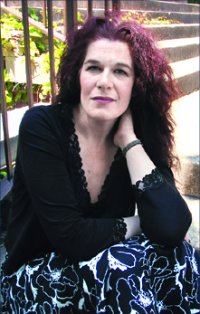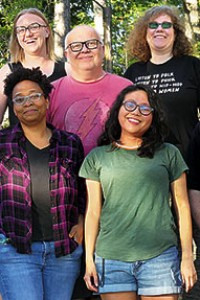Sharyn November: Firebird Rising
 Sharyn November was born in New York City, and earned a BA at Sarah Lawrence College, where she studied poetry. Her work has appeared in Poetry, The North American Review, Shenandoah, and many other publications, and she received a working scholarship to the Bread Loaf Writers’ Conference when she was 21 years old. After some time working as a secretary, she became an editor, and has been at Penguin for over 20 years. She has served on a number of committees of the American Library Association, and the boards of USBBY (the United States Board on Books for Young People – the American chapter of IBBY) and ALAN (the National Council of Teachers of English’s Assembly on Literature for Adolescents).
Sharyn November was born in New York City, and earned a BA at Sarah Lawrence College, where she studied poetry. Her work has appeared in Poetry, The North American Review, Shenandoah, and many other publications, and she received a working scholarship to the Bread Loaf Writers’ Conference when she was 21 years old. After some time working as a secretary, she became an editor, and has been at Penguin for over 20 years. She has served on a number of committees of the American Library Association, and the boards of USBBY (the United States Board on Books for Young People – the American chapter of IBBY) and ALAN (the National Council of Teachers of English’s Assembly on Literature for Adolescents).
She is currently senior editor at Viking Children’s Books and editorial director of Firebird Books, the imprint she founded in 2002. Firebird publishes fantasy reprints and reissues, as well as some original work, including the Firebirds anthology series, edited by November: Firebirds (2003), World Fantasy Award finalist Firebirds Rising (2006), and Firebirds Soaring (2009).
November was nominated for a World Fantasy Award in the Special Award, Professional category in 2004 and 2005. She lives and works in New York City.
Website: it’s sharyn dot org!
 “I think every editor begins as a reader. I was reading when I was very small, obsessively and voraciously, except I didn’t read any genre fiction other than what I found in the children’s section – Edward Eager, Rumer Godden, E. Nesbit, and Lloyd Alexander.
“I think every editor begins as a reader. I was reading when I was very small, obsessively and voraciously, except I didn’t read any genre fiction other than what I found in the children’s section – Edward Eager, Rumer Godden, E. Nesbit, and Lloyd Alexander.
“I had a circuitous path to publishing, and specifically to genre – I’ve never done anything in a linear way. Maybe this is because I find so many things so interesting! I know people who decided they wanted to be editors in high school or elementary school – I didn’t even know what an editor was. I just wanted to read a lot of books!
“At a certain point, though, it was time to figure out what I really wanted to do. I still had no idea. I remember every Sunday, looking in the New York Times job section – and then I saw an ad to be an editorial assistant in children’s books. Like every important life decision, it was like something clicked, or a light went on: ‘This is my job. This is what I’m supposed to be doing.’”
…
 “This was in the early to mid-1990s, a period where YA was considered to be dying. You couldn’t give away a young-adult novel, especially not fantasy, so I was buying a lot of middle-grade and what YA I could – a lot of gritty, realistic fiction.
“This was in the early to mid-1990s, a period where YA was considered to be dying. You couldn’t give away a young-adult novel, especially not fantasy, so I was buying a lot of middle-grade and what YA I could – a lot of gritty, realistic fiction.
“Being a naturally curious person, I decided to get more involved in two areas – the library world and the world of the teen reader. Librarians are the gateways for the middle-grade readers, and young-adult librarians are huge advocates for teenagers, so I joined ALA in 1995. I got to know a very wide range of librarians who were absolutely awesome! (I’m still a member of ALA, and I get to know new librarians all the time. And they are still awesome.)
“In 1997-98, I made up a poll and sent it to librarians who gave it to their readers, and when the polls came back I got a sense of what kids were reading, liking, and not liking…. Then I went out into the field. I started working with teenagers in schools and libraries because they’re using their own money to buy paperbacks, and you want to publish books that will appeal to them. It made sense to go directly to them and start asking questions. Trust me, they do not hold back.
“One group in Princeton, New Jersey – I met with them every month – turned my head around. They became the trigger for the Firebird imprint, because they were all reading genre – and the fastest, best, most voracious readers were all going into the adult section. And, again, something clicked. ”
…
“I’ve heard this for years: adult publishing has become more like Hollywood, and children’s books (especially now) have become more like adult publishing. There’s a lot of high concept, and a lot of huge bidding wars and high advances. Of course you can track a lot of this back to Harry Potter. Everybody’s trying to find out what the ‘next thing’ is. Children’s publishing, especially YA, is now big business.
“Some books are written for adults to give to children, not written for actual teenagers. If they’re dumbed-down, they’re didactic, because there is that teaching impulse that adults have. It may not be intentional, but it’s there.
“The trends are sweeping through faster because the world has sped up. The magic-school trend sort of morphed into urban fantasy and vampires and paranormal romance and steampunk and zombies and mashups. It’s fascinating watching how things get changed, shifted, and looted, to appeal to a mass audience. Vampires aren’t even genre anymore. They turned from horror to erotica to romance – they got safer and safer and safer. You could say that many of the genre best-sellers are romances with whatever clothes of the week are on – paranormal, dystopia, post-apocalyptic, whatever.”



 Excerpts from the interview:
Excerpts from the interview:


Pingback:Tweets that mention Locus Online Perspectives » Sharyn November: Firebird Rising -- Topsy.com